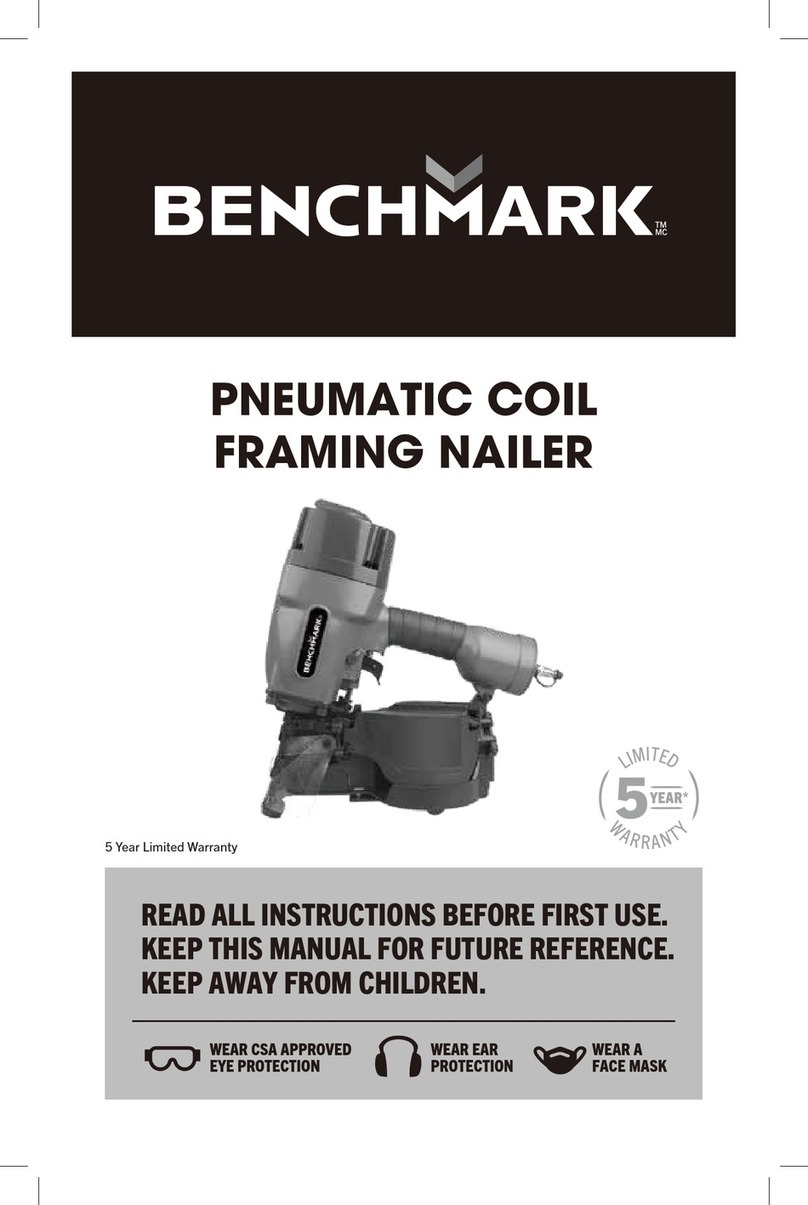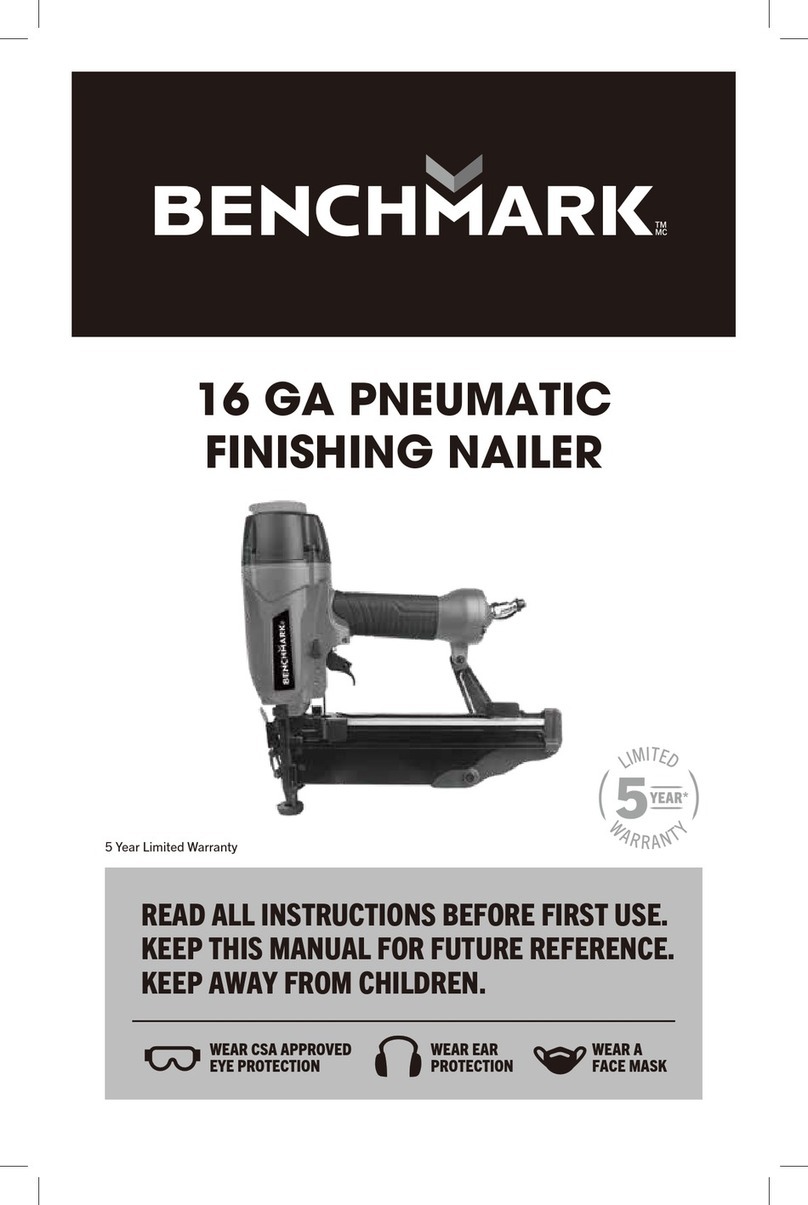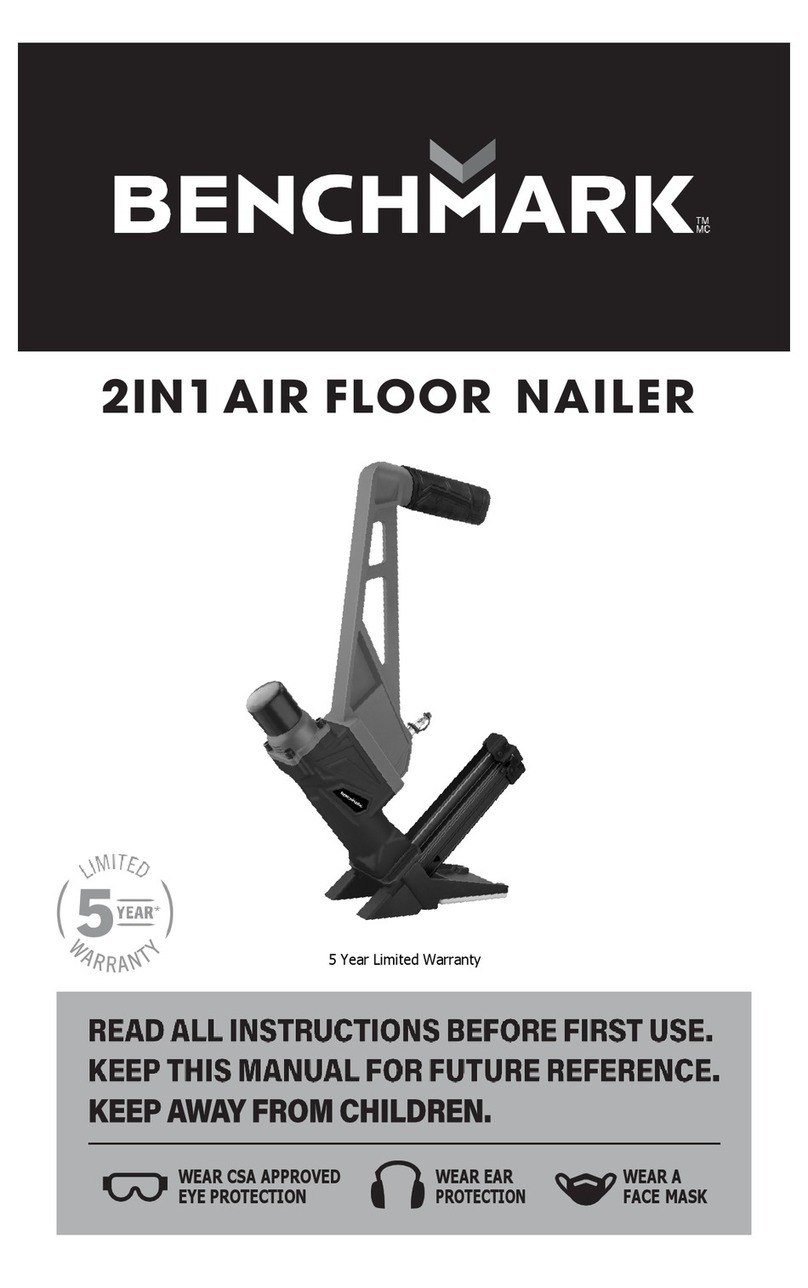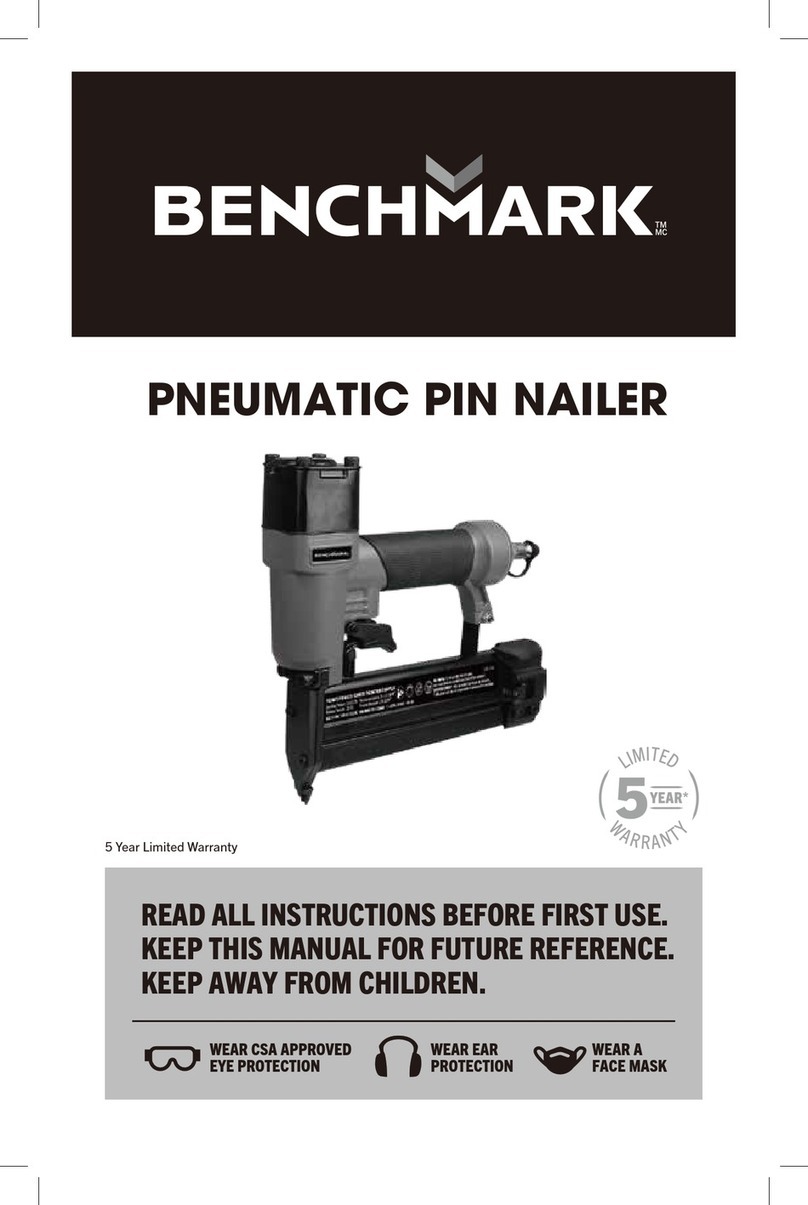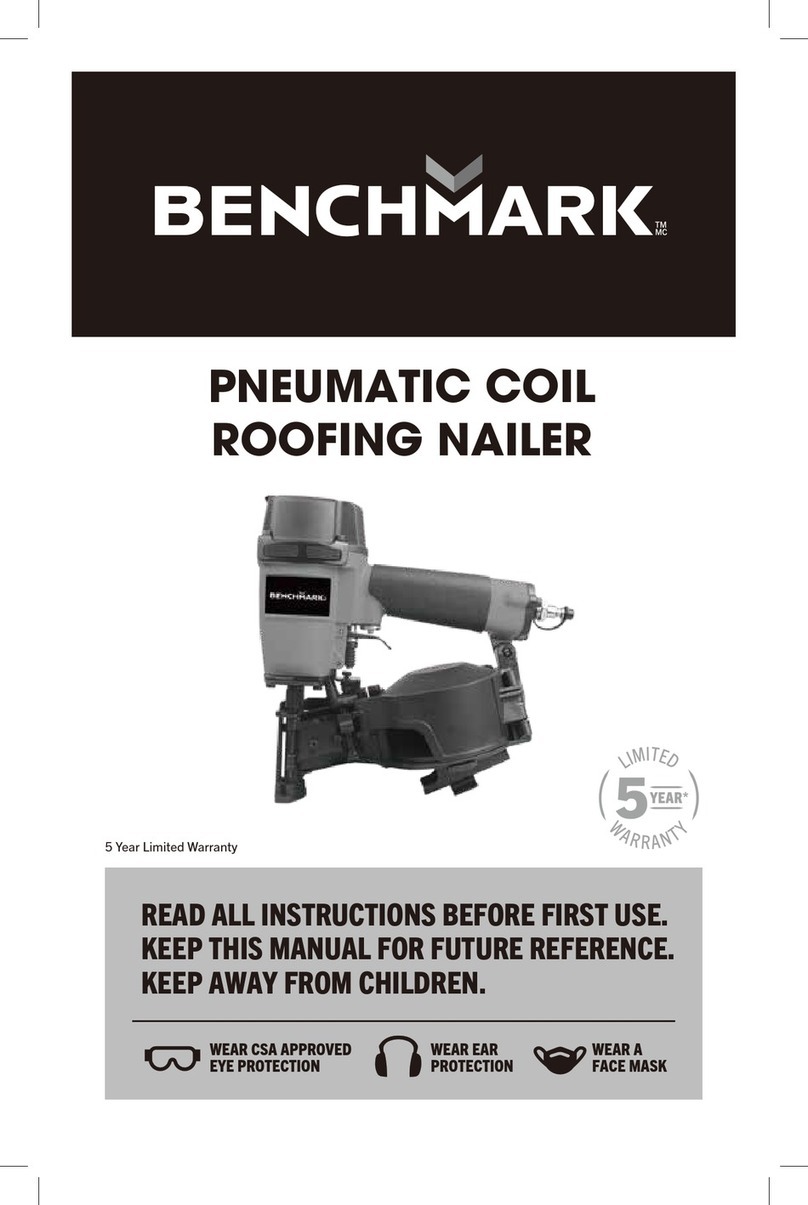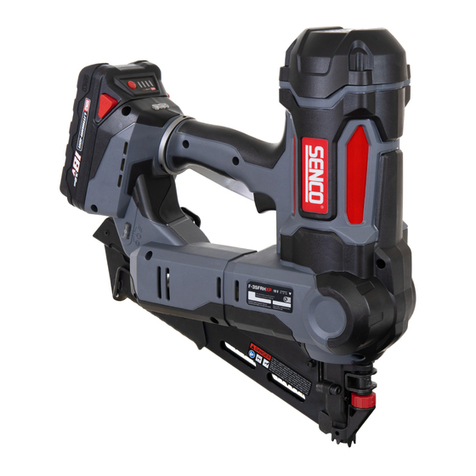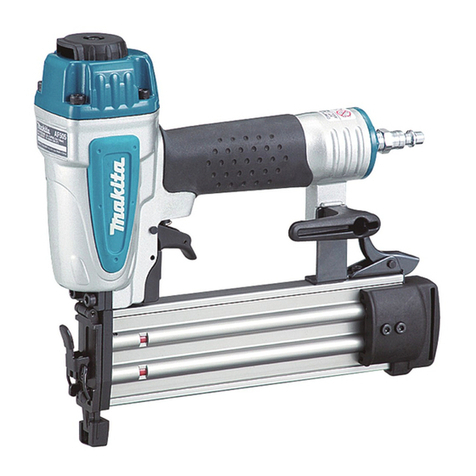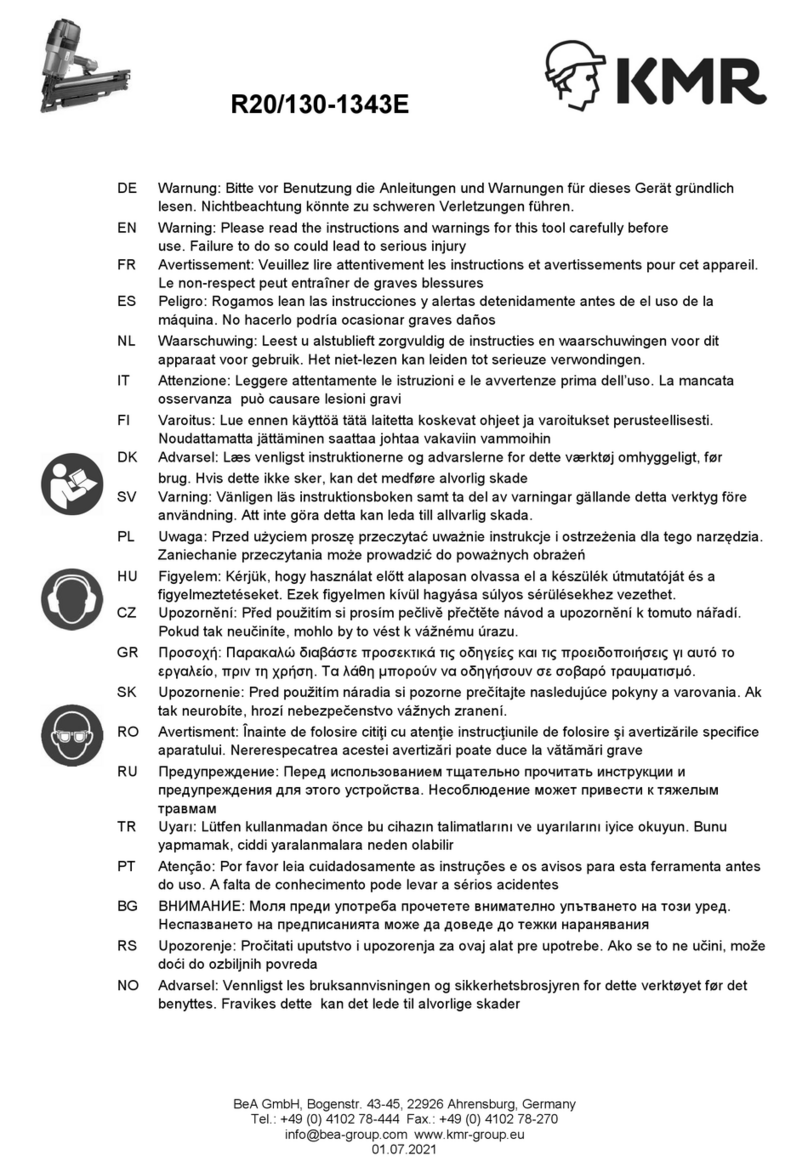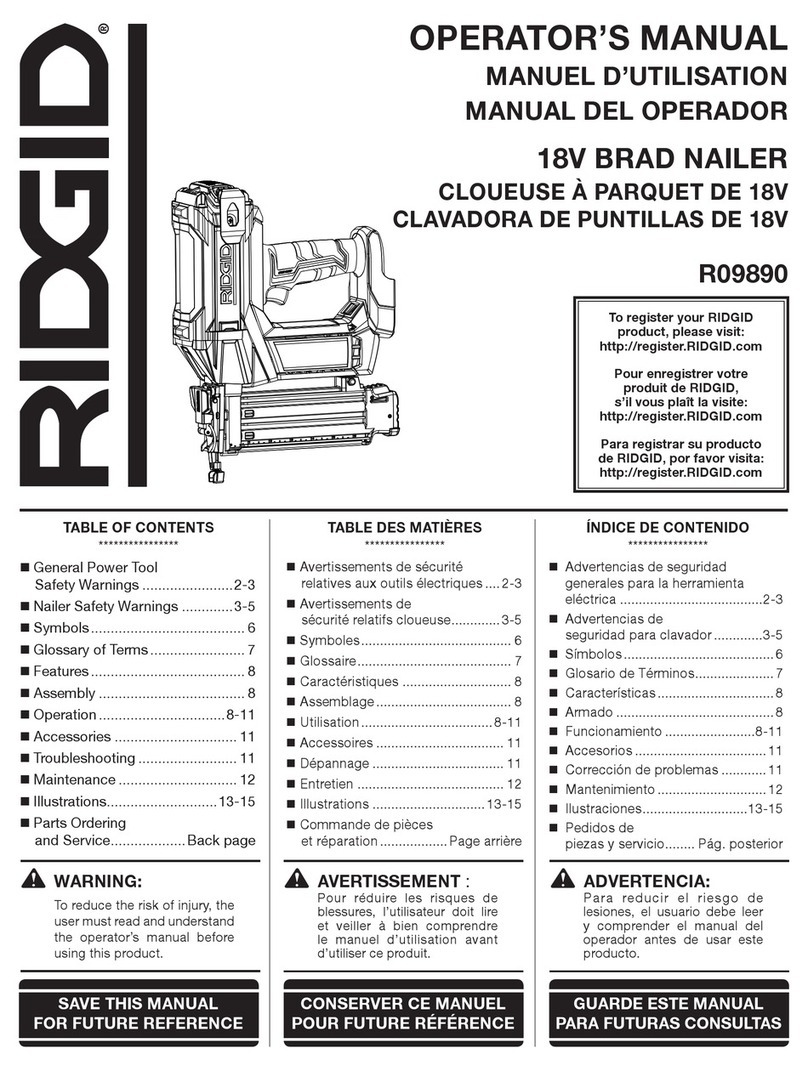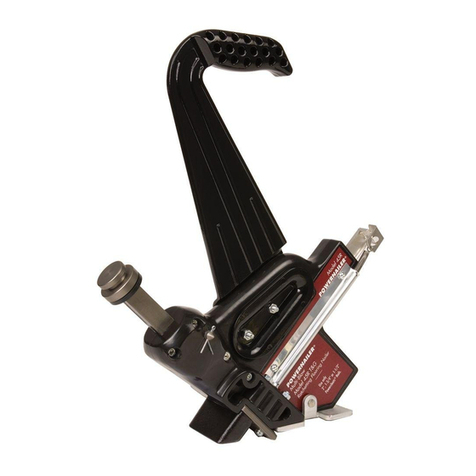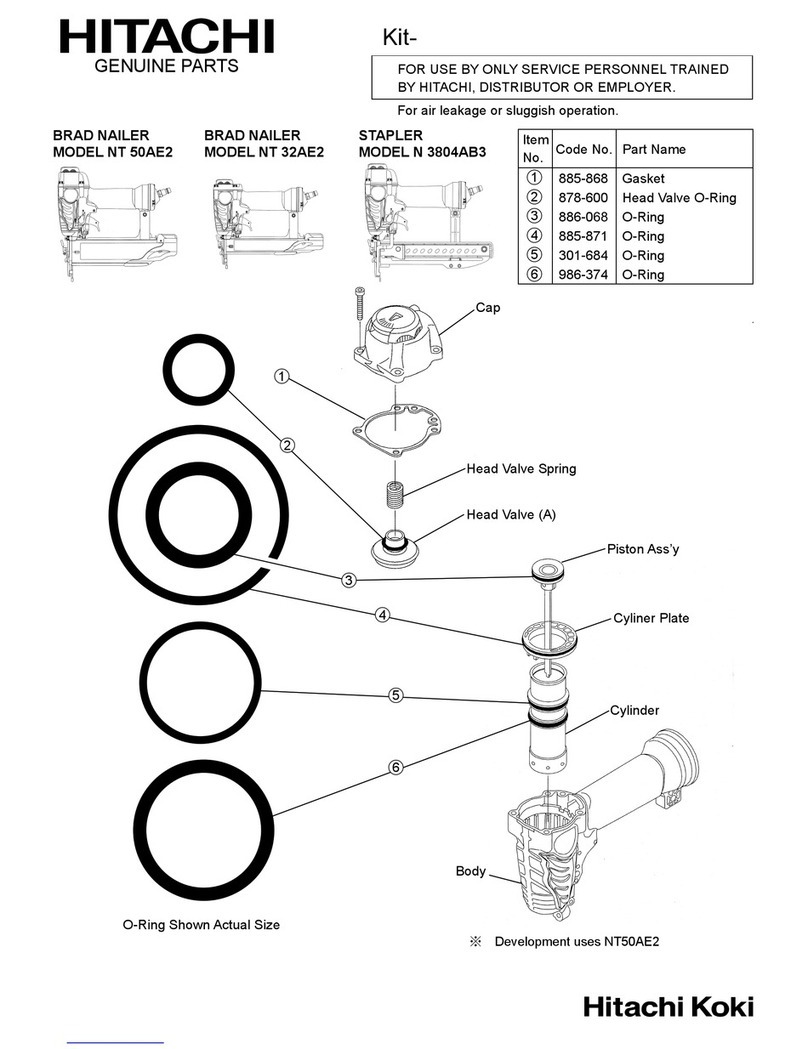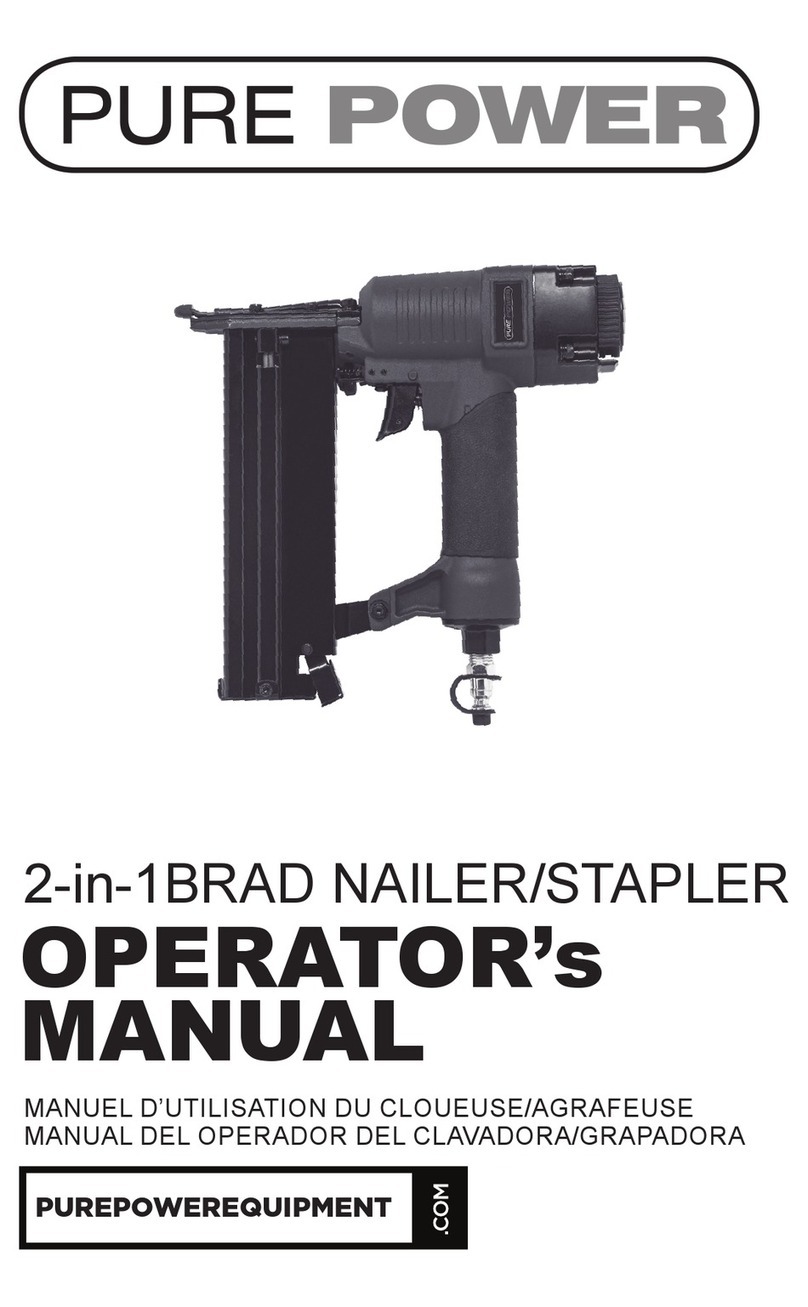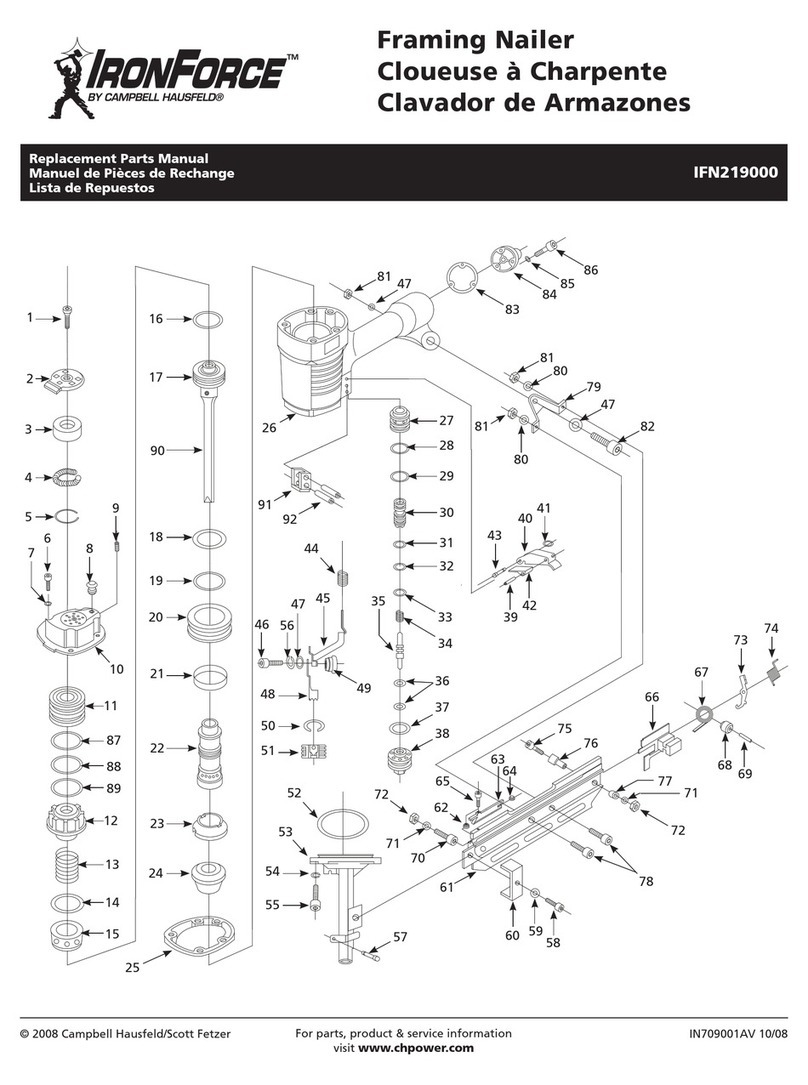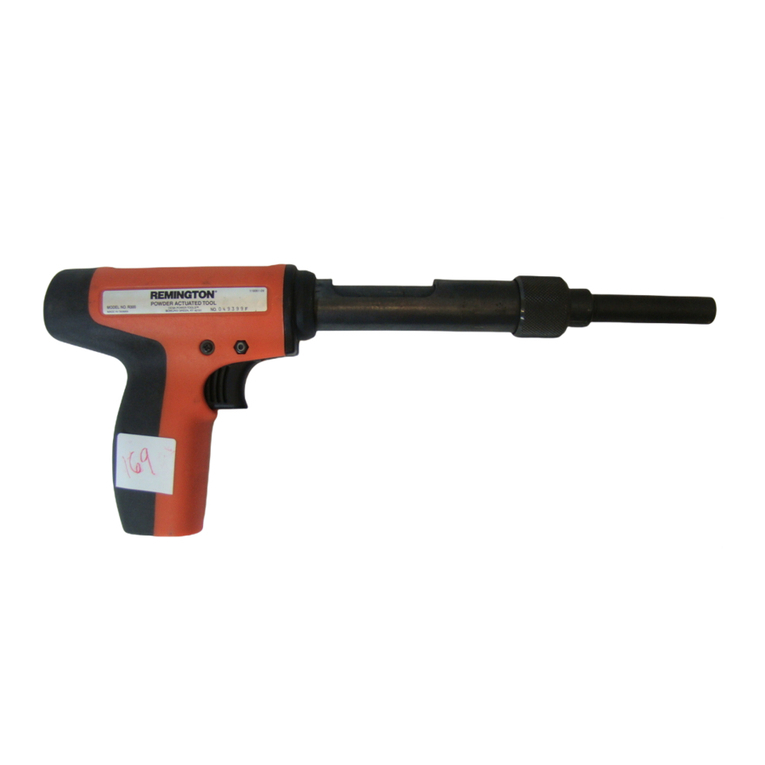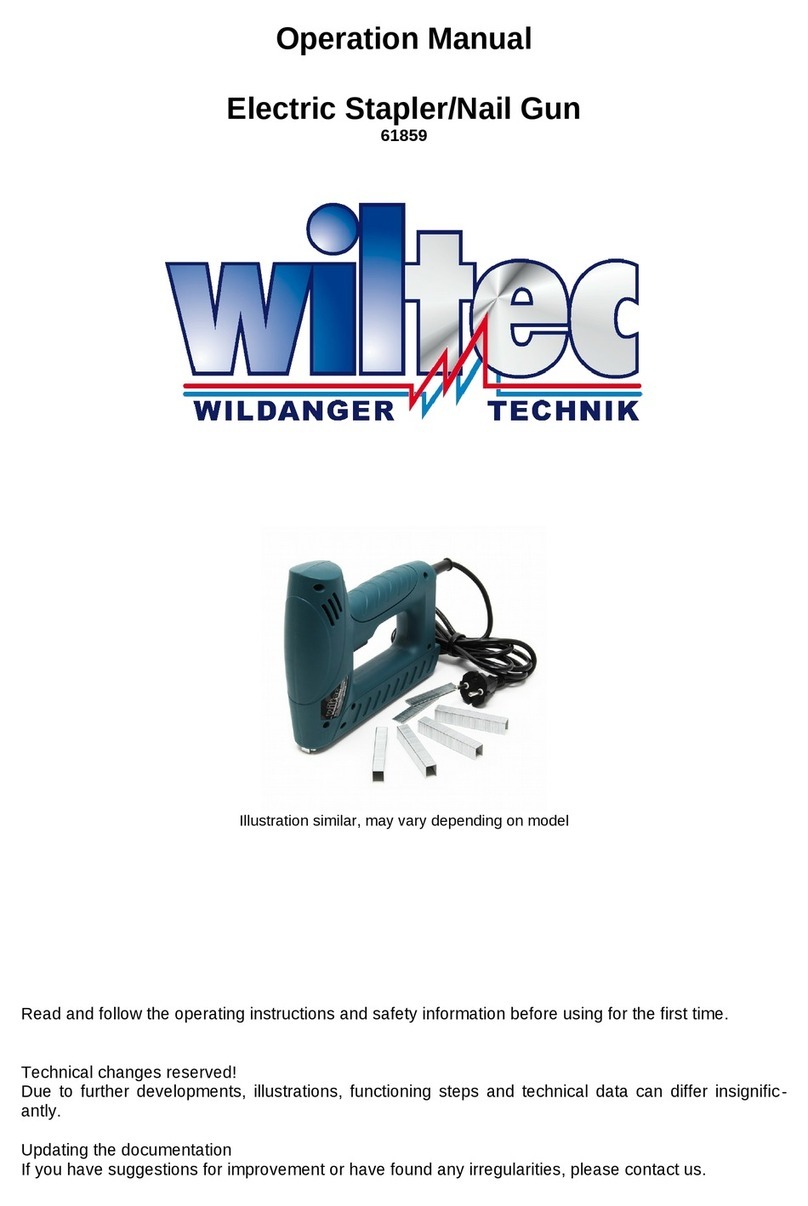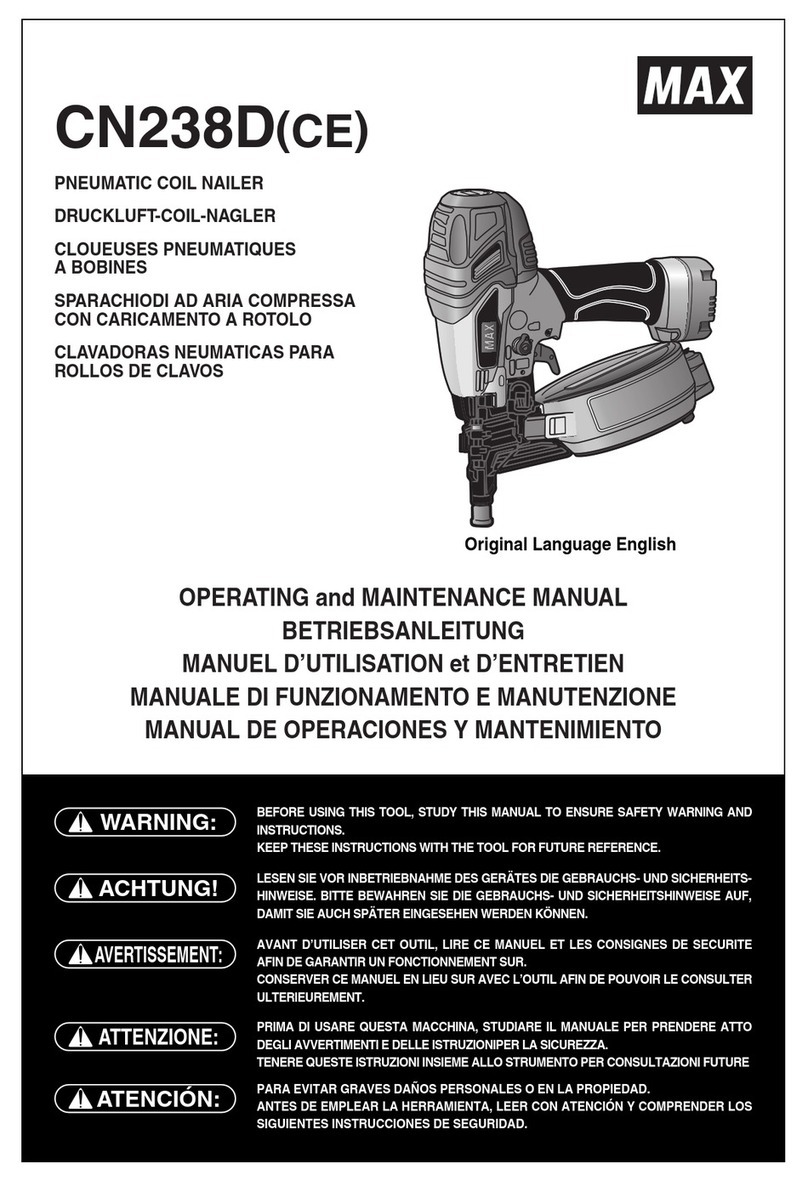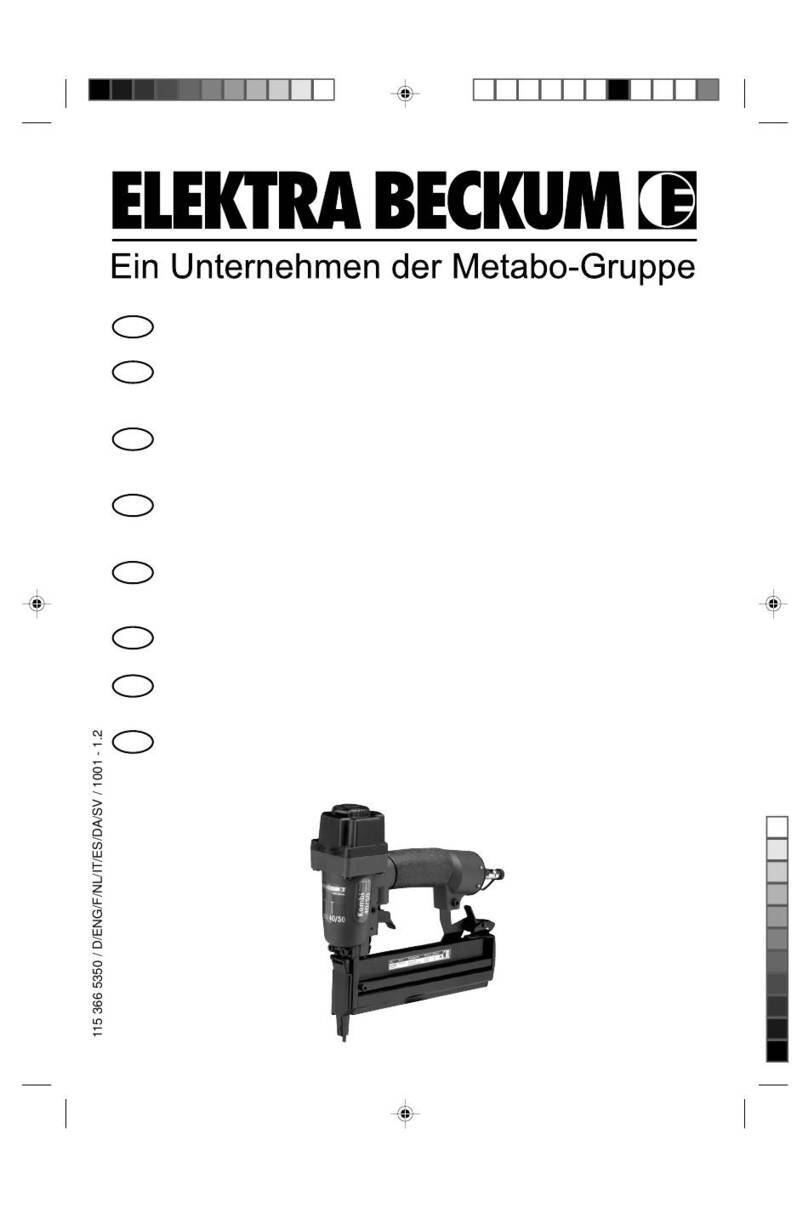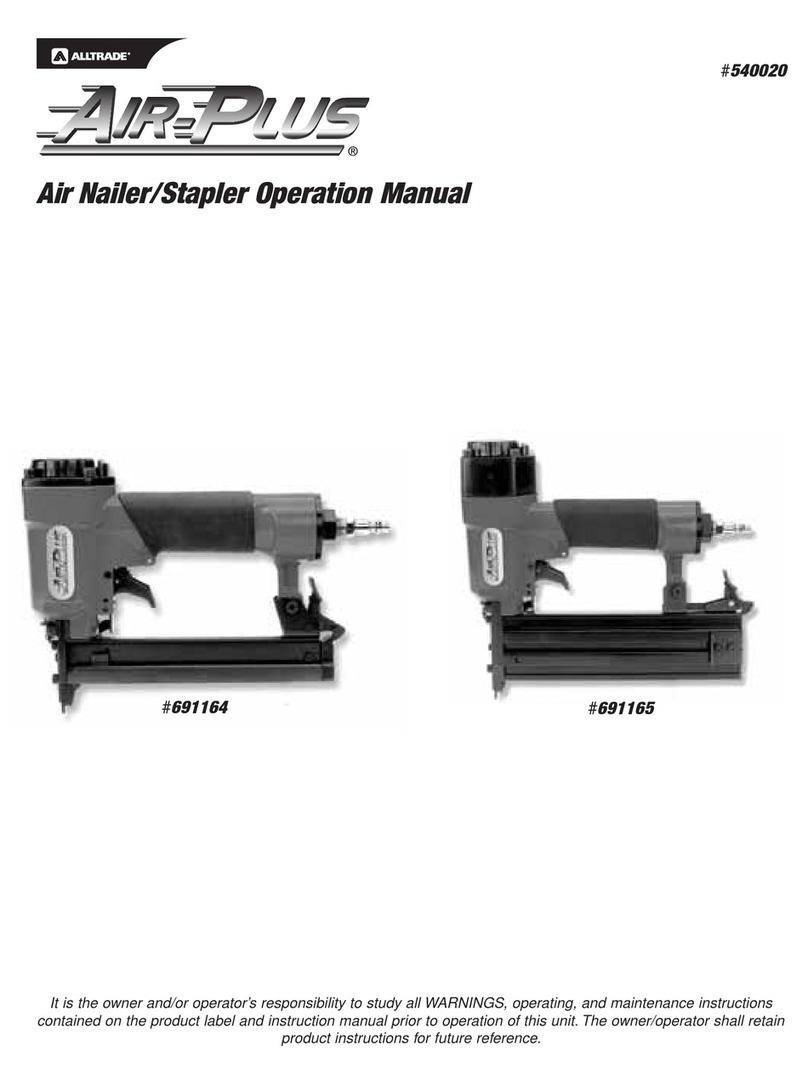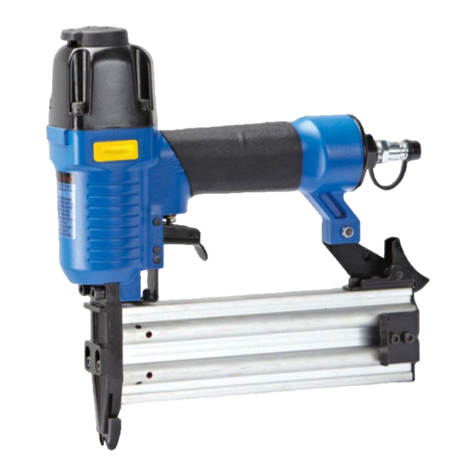Benchmark 1282 151 User manual

WEAR CSA APPROVED
EYE PROTECTION
WEAR EAR
PROTECTION
WEAR A
FACE MASK
READ ALL INSTRUCTIONS BEFORE FIRST USE.
KEEP THIS MANUAL FOR FUTURE REFERENCE.
KEEP AWAY FROM CHILDREN.
5 Year Limited Warranty
PNEUMATIC FRAMING
NAILER

1
PRODUCT SPECIFICATIONS
PNEUMATIC FRAMING NAILER
Magazine capacity(QTY.) 80 PCS
Nailer Drives Fastener Nail length: Clipped head nails:
50mm (2”)-90mm (3-1/2”)
Working pressure 70-110 psi (4.8-7.5 bar)
Maximum pressure 120 psi (8.3 bar)
Weight 8.3 lb (3.8kg)
Air inlet ¼” NPT
Recommended Hose ¼” or 3/8”
Magazine Angle 34
Average air consumption 5.8 CFM @ 90PSI
NEED ASSISTANCE?
Call us on our toll- free customer support line:
1-866-349-8665 (Monday through Friday 9am – 5pm Eastern Standard Time)
Note these instructions pertain to the tool only. Please refer to your
compressors operators manual and follow the manufacturers instructions.
• Technical questions
• Replacement parts
• Parts missing from package
*Please note (where the ¼” NPT connecter is not already installed on the tool) your
tool may be shipped with a black plastic cap installed in the air inlet. Pry the cap
out prior to installing the ¼” NPT connector.

1282 151
PNEUMATIC FRAMING NAILER
2
TABLE OF CONTENTS
Product Specifications................................................................................... 1
Table of Contents........................................................................................... 2
Safety Guidelines ..................................................................................... 3-6
Symbols ....................................................................................................... 7
Tool Specific Warnings .................................................................................. 8
......................................................... 9
Know Your Pneumatic Framing Nailer
...................................................................... 10-18
Assembly And Operating
Maintenance
Troubleshooting
Exploded View
....................................................................................... 19
Parts List .............................................................................................
............................................................................................
.................................................................................... 20-21
Warranty......................................................................................................
22
23-25
26

3
SAFETY GUIDELINES
DANGER! Potential hazard that will result in serious injury or loss of life.
WARNING:
WARNING! Potential hazard that could result in serious injury or loss of life.
CAUTION! Potential hazard that may result in moderate injury or damage to
equipment.
Note - The word " Note " is used to inform the reader of something he / she needs to
know about the tool.
This manual contains information that relates to PROTECTING PERSONAL SAFETY
and PREVENTING EQUIPMENT PROBLEMS. It is very important to read this manual
carefully and understand it thoroughly before using the product. The symbols listed
below are used to indicate this information.
These precautions are intended for the personal safety of the user and others
working with the user. Please take time to read and understand them.
PERSONAL SAFETY
Do not use oxygen or any other combustible or
bottled gas to power air-powered tools. Failure
to observe this warning can cause explosion
and serious personal injury or death.
Use only the compressed air to power the
air-powered tools. Use a minimum of 25’
(7.6 m) of hose to connect the tool to the
compressor. Failure to comply will result in
serious injury or loss of life.
•
Risk of electric shock: Do not expose a compressor to rain.
Store it indoors. Disconnect the compressor from power source
before servicing. Compressor must be grounded. Do not use
grounding adaptors.
•
Risk of personal injury: Do not direct compressed air from the
air hose towards the user or other personnel.
•
Oxygen
Hydrogen
Explosive
Combustible
SYMBOL MEANING

1282 151
PNEUMATIC FRAMING NAILER
4
DANGER!
Keep children away from the work area. Do not allow children to handle
power tools.
Do not use this tool in the presence of flammable liquids or gases. Sparks
that are created during use may ignite gases.
Keep air hose away from heat, oil, and sharp edges. Check air hose for wear
before each use and ensure that all connections are proper.
Always ensure that the workpiece is firmly secured leaving both hands free
to control the tool.
Always ensure that the tool has stopped before putting it down after use, for
safety purposes and to prevent possible damage to the tool/user.
Keep proper footing at all times in order to ensure correct balance.
Always assume that the tool contains fasteners.
Do not point the tool toward yourself or anyone else.
•
•
•
•
•
•
•
•
Risk of inhalation: Never directly inhale the air produced by
the compressor.
•
Risk of bursting: Do not adjust the pressure switch or safety
valve for any reason. They have been pre-set at the factory for
this compressor’s maximum pressure Tampering with the
pressure switch or the safety valve may cause personal injury
or property damage.
•
Risk of burns. The pump and the manifold generate high
temperatures. In order to avoid burns or other injuries, do not
touch the pump, the manifold, or the transfer tube while the
compressor is running. Allow the parts to cool down before
handling or servicing. Keep children away from the
compressor at all times.
•
Risk of bursting: Make sure the regulator is
adjusted so that the compressor outlet
pressure is set lower than the maximum
operating pressure of the tool. Before
starting the compressor, pull the ring on
the safety valve to make sure the valve
moves freely. Drain water from tank after
each use. Do not weld or repair tank.
Relieve all pressure in the hose before removing or attaching
accessories.
•
SYMBOL MEANING

5
WARNING!
Do not allow unskilled or untrained individuals to operate the air tool.
Do not use the tool for any task other than that it is designed to perform.
Locate the compressor in a well-ventilated area for cooling, and a minimum
of 12” (31 cm) away from the nearest wall.
Protect the air hose and the power cord from damage and puncture. Inspect
them for weak or worn spots every week and replace them if necessary.
Always wear hearing protection when using the air compressor. Failure to do
so may result in hearing loss.
Do not carry the compressor while it is running.
Do not operate the compressor if it is not in a stable position.
Do not operate the compressor on a rooftop or an elevated position that
could allow the unit to fall or be tipped over.
Always replace a damaged gauge before operating the unit again.
Do not connect the tool to a compressed air source with a pressure output
that is higher than 120psi.
•
•
•
•
•
•
•
•
•
•
CAUTION!
Always ensure that the tool has stopped before disconnecting the air supply.
Do not wear watches, rings, bracelets, or loose clothing when using any
air- powered tool.
Do not overload the tool. Allow the tool to operate at its optimum speed for
maximum eciency.
Do not use a tool that is leaking air, that has missing or damaged parts, or
that requires repairs. Verify that all screws are securely tightened.
For optimal safety and tool performance, inspect the tool before every usage,
in order to ensure free movement of the trigger, safety mechanisms, and
springs.
Always keep your air tool clean and lubricated. Daily lubrication is essential
to avoid internal corrosion and possible failures.
Ensure the floor is not slippery and wear non-slip shoes. Floors should be
kept clean and clear.
Always follow all workshop safety rules, regulations, and conditions when
using the tool and keep the work area clean.
Carry the tool by the handle only, keeping fingers away from the trigger. Do
not carry the tool by the hose, magazine, or any other parts.
Do not use the tool near or below freezing point, as doing so may cause tool
failure.
Do not store the tool in a freezing environment to prevent ice formation on
the tools operating valves, as doing so may cause tool failure.
Handling and storage of oil: Use with adequate ventilation. Avoid contact of
oil with eyes, skin, and clothing. Avoid breathing spray or mist. Store in a
tightly closed container in a cool, dry, well-ventilated area free from
Incompatible substances.
Tripping hazard. The air hose may become a tripping hazard when it is
placed in the work area. Use care when walking in the work area.
•
•
•
•
•
•
•
•
•
•
•
•
•

1282 151
PNEUMATIC FRAMING NAILER
6
CAUTION!
Disconnect tool from the air supply and turn o the
compressor before performing any maintenance or
changing accessories, when clearing a jammed
fastener, when the tool is not in use, when it is being
handed to another person, and when it is left
unattended. Failure to comply may result in
moderate injury or damage to equipment.
•
Use safety goggles and ear protection: Wear safety
glasses with side shields when operating the tool/
compressor and verify that others in the work area
are also wearing safety glasses. Safety glasses must
conform to American National Standards Institute
(ANSI Z87. 1) requirements and must provide
protection from flying particles from the front and
the sides.
Air-powered tools are loud, and the sound can cause hearing damage.
Always wear ear protection to prevent hearing damage and loss. Failure to
comply may result in moderate injury.
Note: Recycle unwanted materials rather than disposing of them as waste. Sort the
tools, hoses, and packaging in specific categories and take to the local recycling
centre or dispose of in an environmentally safe way.
•

7

1282 151
PNEUMATIC FRAMING NAILER
8
Do not disconnect or reconnect the air hose with the tool pressed or with a
fastener in the guide. The tool may fire when it is reconnected to the air
supply.
•
TOOL SPECIFIC WARNINGS
DANGER Potential hazard that will result in serious injury or death.
Keep hands and other parts of the body away from the nail guide during use.
Keep hands and feet and all other parts of the body at least 8” (20cm) away
from the firing head.
Objects in the workpiece can cause serious injury if they cause the fasteners
to be deflected or to be driven away from the point of entry.
Do not drive fasteners on top of a fastener. The fastener may ricochet,
causing serious personal injury.
Do not drive fasteners on scaoldings, ladders, or such similar construction.
Use only fasteners of the proper size and gauge, as specified in this manual.
Do not drive fasteners close to the edge of the workpiece.The workpiece may
split which could allow the fastener to fly free or ricochet and cause serious
personal injury.
•
•
•
•
•
•
WARNING Potential hazard that could result in serious injury or death.

9
KNOW YOUR
PNEUMATIC FRAMING NAILER
Magazine
Air quick coupler
Nailer body
Mode selection
switch
Depth
adjustment dial
Spring loaded slide
Cylinder Cap
Trigger

ASSEMBLY AND OPERATING
1282 151
PNEUMATIC FRAMING NAILER
10
Be sure to use a proper air compressor with air-powered tools. The compressor
should be able to supply a minimal air delivery of 5.8 SCFM @ 90 psi to ensure the
compressor can run continuously with the tool.
COMPATIBLE COMPRESSORS
GUIDELINES FOR PROPER USE AND OPERATION
Air Compressor
Size & Power
>0.6g/cm3<2.5" (63 mm)
≥2.5" (63 mm)
<2.5" (63 mm)
≥2.5" (63 mm)
100 psi
110 psi
70 psi
110 psi
≤0.6g/cm3
Wood density Nail size Compressor air pressure
4 - 6 Gallons Light duty and
intermittent use
Light duty and
intermittent use
Light duty and
intermittent use
8 - 11 Gallons Light duty and
intermittent use
Medium duty and
intermittent use
Medium duty and
intermittent use
15+ Gallons Medium duty and
intermittent use
Heavy duty and
continuous use
Heavy duty and
continuous use
1 1/2 – 2 HP 2 1/2 HP 3 HP and more

11
Always use clean, dry, regulated, compressed air at 70-110 psi (4.8-7.5 bar). Do
not exceed the maximum or minimum pressures. Operating the tool at the wrong
pressure (too low or too high) will cause excessive noise or rapid wear of tool.
Air system
No. Description No. Description
Pneumatic framing nailer
Quick connector
Quick coupler
Air hose
Lubricator
Regulator (0 to 8.5 bar)
Filter
Cut-o valve
Air compressor
1
2
3
4
5
6
7
8
9
257
133
6
8
9
4
Always use clean, dry, regulated compressed air at 4.8 to 7.5 bar (70 to 110 PSI).
Do not exceed the maximum and minimum pressures. Operating the tool at the
wrong pressure will cause excessive noise, fast wear, or misfiring.
It is recommended that a filter-regulator-lubricator be used and be located as
close to the tool as possible.
If a filter-regulator-lubricator is not installed, place up to 6 drops of compressor
oil into the air inlet plug before each use.
If a filter-regulator-lubricator is installed, keep the air filter clean. A dirty filter will
reduce the air pressure to the tool, which will cause a reduction in power,
eciency, and general performance.
For optimal performance, install a quick connector to the tool and a quick coupler
on the hose, if applicable
Verify that all the connections in the air supply system are sealed in order to
prevent air from leaking.
•
•
•
•
•
•
•
WARNING! Potential hazard that could result in serious injury or loss of life.
Note: Please note that the filter-regulator-lubricator and air hose are sold separately.
Read this Instruction Manual carefully before using the nailer.

1282 151
PNEUMATIC FRAMING NAILER
12
WARNING! Potential hazard that could result in serious injury or loss of life.
• The use of any other types of nails will cause the nailer to jam and could lead
to serious injury.
This nailer can be used with a variety of shank types (e.g., ring, smooth, spiral) and a
variety of coatings or nail compositions (e.g., Electro, mechanical, hot-dipped
galvanized or stainless steel, etc.).
Length: 2 - 3 1/2" (50 to 90 mm) (Fig A) Angle: 34° (Fig B)
ACCEPTABLE NAILS
These icons are used to select the proper nails for this specific nailer.
Note: Icons are color-coded, please refer the actual tool for the specific color
Nail type icons
This Pneumatic framing nailer drives 2 - 3 1/2" (50 to 90mm) long clipped-head
framing nails.
3.5”
2”
fig A fig B
34º

13
DANGER! Potential hazard that will result in serious injury or loss of life.
• Disconnect the tool from the compressed air source before loading nails.
• Do not point the tool towards the operator or other people while changing or
loading nails.
• Do not hold the tool with the trigger pressed while loading or changing the
nails. Failure to comply will lead to serious injury or loss of life.
Disconnect the tool (1) from the air supply (2) (fig C).
OPERATING INSTRUCTIONS
Loading nails
1.
Take hold of the nailer firmly with one hand and use the other hand to press the
spring-loaded slide (1) on the magazine and slide it back toward rear of tool (fig D).
2.
Features of the pneumatic framing nailer
This lightweight pneumatic framing nailer drives 2 to 3 1/2" (50 to 90 mm) long
pneumatic framing nails.
It features
– a hardened one-piece piston and an open magazine designed for easy
extraction of jammed nails.
– a rubber grip handle for improved control and added comfort, even during
extended use.
– a tool-free driving depth adjustment for driving nails flush or countersunk into
various materials, which keeps projects moving.
– a rear-loading magazine made of extruded aluminum for lighter weight and
added durability.
The hardened claw tip reduces wear and limits slippage when the tool is driven
at an angle.
Both sides of the main body protect both the operator and the workpiece.
This framing nailer is ideal for construction framing, wall sheathing, roof
sheathing, floor decking and similar applications.
•
•
•
•
•
fig C fig D
1
2
1

WARNING! Potential hazard that could result in serious injury or loss of life.
Do not operate the tool if the nails are not loaded, doing so may damage the
tool.
Do not fire nails into the air, doing so may cause injury to the operators or
others, apart from damaging the tool.
Load the correct type of nails only and do not load dierent sized nails into
the magazine, as doing so may cause nails to jam. Failure to comply could
lead to serious injury or loss of life.
fig E fig F
Insert a strip of nails into the magazine. Ensure the points of the nails are facing
down. Be sure to insert the heads of the nails into the channel. Release the
spring- loaded slide until it meets the nails and locks in place to close the
magazine (1) (Fig. E).
3.
•
•
•
WARNING! Potential hazard that could result in serious injury or loss of life.
Always know the operational mode of the nailer before using it. Failure to
comply could lead to serious injury or loss of life.
•
WARNING! Potential hazard that could result in serious injury or loss of life.
Hold the gun properly and mind the kick-back after each nail shot. Failure
to comply will lead to serious injury or loss of life.
•
1282 151
PNEUMATIC FRAMING NAILER
14
Plug in compressor, turn it on and set the pressure regulator to 90psi, attach one
end of the air hose to the compressor and the other end of the air hose (1) to the
tool (2). Use plumber’s tape to avoid air leak (fig F).
4.
Test the driving depth using a sample piece of wood before working on the
workpiece. See wood density chart on page 9.
5.
1
2
1

15
The Framing Nailer has two firing modes: Single-Sequential actuation for single
firing, or Contact / bump actuation for repetitive, fast firing of nails. You may switch
between these two modes simply by adjusting the Mode Selection Switch on the tool.
For single sequential actuation mode, the selector switch must be positioned toward
the back of the tool (toward the single nail icon on the tool. For repetitive firing, also
know as contact or bump mode, the mode selector switch must be positioned toward
the front of the tool (toward the multiple nail icon on the tool).
Note: Refer to the graphic imprinted
below the trigger and adjust the firing
depth accordingly.
FIRING MODES
For varying materials, the nail depth
can be tool- free adjusted with the
depth adjustment dial (Fig G)
•
Adjusting nail depth
fig G
Turn the depth adjustment dial (1) clockwise (with the discharge area of the tool
facing away from the operator) (fig H).
Increasing nail depth
fig H fig I
Turn the depth adjustment dial (1) counter- clockwise (with the discharge area of
the tool facing away from the operator) (fig I).
Note: If after adjustment the nail is not going deep enough, adjust the pressure of
the regulator on the compressor accordingly.
Ensure the switch is positioned either fully in single sequential or contact/bump
mode, otherwise, if switch is in-between the tool will not function properly.
Decreasing nail depth
MODE SELECTION SWITCH

1282 151
PNEUMATIC FRAMING NAILER
16
The single sequential actuation mechanism is for use where precise fastener
placement is desired. The single sequential actuation mechanism may reduce the
possibility of bodily injury to you or others in the work area compared to the
contact/bump actuation mechanism. This is because it is less likely to drive an
unwanted nail if you keep the trigger pulled and accidentally bump the push lever
against yourself or others.
The single sequential actuation mechanism may also reduce the speed of operation
compared to the contact/bump actuation mechanism. The single sequential
actuation mechanism is recommended to inexperienced users.
SINGLE SEQUENTIAL ACTUATION MODE
1. Set switch on tool to single sequential actuation mode (fig. J).
2. Position the nose of the tool on the workpiece with your finger o the trigger.
3. Depress the push lever on the firing head of the tool firmly against the workpiece
until it is completely depressed.
4. Pull the trigger to drive a nail.
5. Remove finger from the trigger.
6. To continue nailing in a separate location, move the nailer along the wood,
repeating steps 2-5 as required
1. Set switch on tool to contact or bump mode (fig. J).
2. Press and hold the trigger while operating in this mode. Each time the firing head
contacts a workpiece, a nail is actuated (fired). Lift the nailer and locate it at the
site for the next nail. Move the nailer along the workpiece with a bouncing
motion. Each depression of the push lever on the firing head of the tool will drive
a nail. As soon as the desired number of nails have been driven, remove finger
from the trigger.
3. This process can be repeated until the trigger is released. Extreme care should
be taken because a nail will be driven when the firing head contacts any surface.
4. Since nails can be actuated without removing the finger from the trigger, this is a
less controlled mode, suitable for more experienced users.
* This mode is suitable when less precise nail placement is required. It allows the
user to work more quickly.
Mode
selection
switch
Single sequential actuation mechanism
(Switch toward back of tool)
Bump/Contact mechanism
(Switch toward front of tool)
fig J
CONTACT OR BUMP MODE

17
WARNING! Potential hazard that could result in serious injury or loss of life.
•
•
Keep your finger of the trigger except during fastening operation because
serious injury could result if the push lever on the nose of the tool
accidentally contacts you or others in work area.
Keep hands and body away from the discharge area. This nailer may
bounce from the recoil driving a fastener and unwanted subsequent
fastener may be driven, possibly causing injury.
WARNING! Potential hazard that could result in serious injury or loss of life.
To avoid double firing or accidental firing due to recoil
1) Do not press the nailer against the wood with excessive force.
2) Separate the nailer from the wood as it recoils after nailing.
•
•
Always handle nails and package carefully. If nails are dropped, collating plastic
may be broken.
After nailing:
1) Disconnect air hose from the nailer.
2) Remove all nails from the nailer.
3) Supply 5-10 drops of pneumatic tool lubricant into the air inlet plug on the nailer.
4) Open the petcock on the air compressor tank to drain any moisture.
NOTE:
Only those fasteners specified under product specification may be used when filling
the magazine, hold the tool so that the muzzle is not pointing towards the operator
or any other person or animals.
Filling the magazine
To clear a jammed nail
• Disconnect the tool from the air supply line.
Remove the nails that are stored in the tool’s magazine.
Clearing a jammed nail
WARNING! Potential hazard that could result in serious injury or loss of life.
•
•
•
•
•
•
Disconnect the air hose from the tool and remove the non-jammed nails
from the tool before clearing a jammed nail.
The nails are under pressure and failure to comply could cause them to be
fired out of the tool causing serious injury.
Use pliers or any appropriate tool to remove the jammed nails.
Reload the nails into the tool magazine.
Reconnect the air hose to the tool’s air inlet.
Test fire 3 to 5 nails into a piece of scrap wood in order to ensure a proper
operation.
WARNING! Potential hazard that could result in serious injury or loss of life.
• Do not point the tool towards the operator or other people. Serious personal
injury could result if these instructions are not followed.

1282 151
PNEUMATIC FRAMING NAILER
18
If it is necessary to store the tool for an extended period of time, apply a generous
amount of lubrication before storing. The tool should be allowed to run for
approximately 30 seconds after lubricating in order to ensure that the lubrication is
uniformly distributed throughout the tool.
STORAGE

DANGER!
Disconnect the tool from the air compressor before maintenance/service,
adjusting, cleaning jams, reloading, and when it is not in use. Repairs must be
performed by a qualified service technician only. Failure to comply will lead to
serious injury or loss of life.
MAINTENANCE
Lubrication: If the tool and the compressor are not equipped with an in -line
lubrication system, place up to 6 drops of pneumatic tool oil into the air inlet before
each use or after every 2 hours of continuous use, depending on the characteristics
of the workpiece and type of fasteners used.
Air-operated tools must be inspected periodically, and worn or broken parts must
be replaced to ensure that the tools are operating safely and eciently.
Inspect and replace worn or damaged O-rings, seals, etc. Tighten all screws and
caps frequently in order to help prevent personal injury.
Keep the magazine of the tool clean and free of any dirt or abrasive particles.
MAINTENANCE
REQUIRED
TOOLS OR
MATERIALS
REQUIRED
Each Use or
every 2 Hrs. Monthly As
Needed
DESCRIPTION
MAXIMUM SERVICE INTERVAL
General inspection –
free movement
Trigger, spring,
safety mechanism
In-depth inspection Worn or broken
parts
Replace worn or
broken parts
Lubrication See below Pneumatic tool
oil
None X
X X
X
X
Note: Do not store the tool anywhere temperatures will fall below freezing.
19
Table of contents
Other Benchmark Nail Gun manuals
